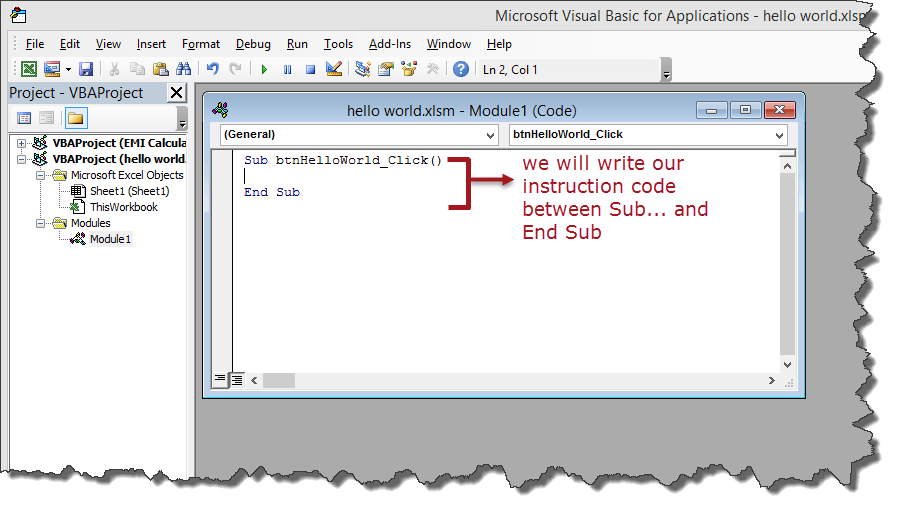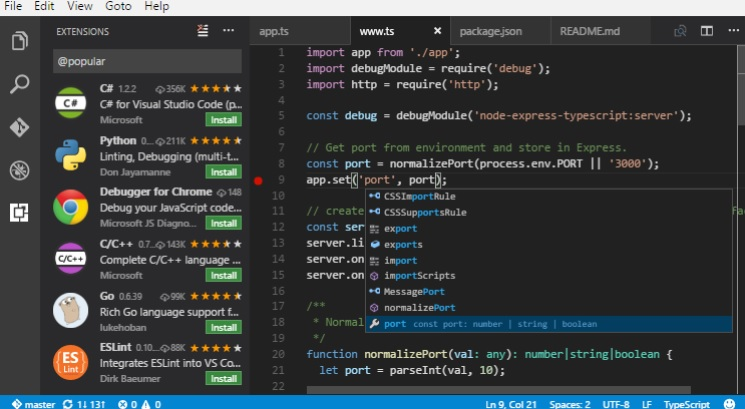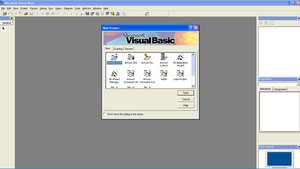Program Structure and Code Conventions Contains documentation on the basic structure and code conventions of Visual Basic, such as naming conventions, comments in code, and limitations within Visual Basic. Visual Basic Language Features Provides links to topics that introduce and discuss important features of Visual Basic, including LINQ and XML literals. COM Interop Explains the interoperability issues associated with creating and using component object model (COM) objects with Visual Basic. VBA stands for V isual B asic for A pplications, an event-driven programming language from Microsoft. It is now predominantly used with Microsoft Office applications such as MSExcel, MS-Word and MS-Access. This tutorial teaches the basics of VBA. Each of the sections contain related topics with simple and useful examples.
In visual basic, Arrays are useful to store multiple elements of the same data type at contiguous memory locations and arrays will allow us to store the fixed number of elements sequentially based on the predefined number of items.
In the previous chapter, we learned about variables in visual basic, which will help us to hold a single value like Dim id AsInteger =10. In case, if we want to hold more than one value of the same data type, then the arrays came into the picture in visual basic to solve this problem.

An array can start storing the values from index 0. Suppose if we have an array with n elements, then it will start storing the elements from index 0 to n-1.
Following is the pictorial representation of storing the multiple values of the same type in a visual basic array data structure.
If you observe the above diagram, we are storing the values in an array starting from index 0 and it will continue to store the values based on the defined number of elements.
Visual Basic Arrays Declaration
In visual basic, Arrays can be declared by specifying the type of elements followed by the brackets () like as shown below.
Here, array_name represents the name of an array and Data_type will represent the data type of elements to store in an array.
For example, the following are the different ways of declaring an array with different data types in a visual basic programming language.
' Store only int values
Dim numbers AsInteger()
' Store only string values
Dim names AsString()
' Store only double values
Dim ranges AsDouble()
If you observe the above examples, we declared arrays with required data types based on our requirements.
In visual basic, array elements can be of any type and by default, the values of numeric array elements are set to zero and the reference elements are set to null.
Visual Basic Arrays Initialization

In visual basic, Arrays can be initialized by creating an instance of an array with New keyword. By using the New keyword, we can declare and initialize an array at the same time based on our requirements.
Following are the different ways of declaring and initializing array elements by using New keyword in a visual basic programming language.
' Declaring and Initializing an array with size of 5
Dim array AsInteger() = NewInteger(4) {}
' Defining and assigning an elements at the same time
Dim array2 AsInteger() = NewInteger(4) {1, 2, 3, 4, 5}
' Initialize with 5 elements will indicates the size of an array
Dim array3 AsInteger() = NewInteger() {1, 2, 3, 4, 5}
' Another way to initialize an array without size
Dim array4 AsInteger() = {1, 2, 3, 4, 5}
Visual Basic Programming
' Declare an array without initialization
Dim array5 AsInteger()
array5 = NewInteger() {1, 2, 3, 4, 5}
If you observe the above examples, in the first statement we declared and initialized an integer array with the size of 5 to allow an array to store 5 integer values and the array can contain elements from array[0] to array[4].
In the second statement, we declared and initialized an array same like the first statement but also assigned a value to each index followed by curly brackets { }.
In third and fourth statements, while declaration we initialized an array with values, but without specifying any size. Here, the size of an array can be determined by the number of elements so the size initializer is not required if we are assigning elements during the initialization.
In visual basic, we can declare an array variable without initialization, but we must use the New keyword to assign an array to the variable.
In the fifth statement, we declared an array without initialization and we used New keyword to assign array values to the variable.
In visual basic after an array declaration, we can initialize array elements using index values. Following is an example of declaring and initializing array elements using individual index values in visual basic.
int[] array = newint[5];
array[0] = 1;
array[1] = 2;
array[2] = 3;
array[3] = 4;
array[4] = 5;
If you observe the above example, we initialized array elements separately by using index values.
Visual Basic Accessing an Array Elements
In visual basic, we can access array elements by using for loop or foreach loop or with particular index numbers.
Following is the code snippet of accessing array elements by using particular index numbers.
Dim array AsInteger() = NewInteger(4) {1, 2, 3, 4, 5}

Dim a AsInteger = array(1)
Dim b AsInteger = array(4)
If you observe the above code, we are trying to access array elements using index values in visual basic.
Following is the example of declaring, initializing and accessing array elements with particular index numbers in a visual basic programming language.
Module Module1
Sub Main()
Dim array AsInteger() = NewInteger(4) {1, 2, 3, 4, 5}
Console.WriteLine(array(0))
Console.WriteLine(array(1))
Console.WriteLine(array(2))
Console.WriteLine(array(3))
Console.WriteLine(array(4))
Console.WriteLine('Press Enter Key to Exit..')
Console.ReadLine()
EndSub
EndModule
If you observe the above example, we declared and initialized an array with 5 elements and we are accessing array elements using index values.
When we execute the above visual basic program, we will get the result as shown below.
If you observe the above result, we are able to access array elements using index numbers based on our requirements.
Visual Basic Access Array Elements with For Loop
In visual basic, by using for loop we can iterate through array elements and access the values of an array with length property.
Following is the example of accessing array elements using for loop in a visual basic programming language.
Module Module1
Sub Main()
Dim array AsInteger() = NewInteger(4) {1, 2, 3, 4, 5}
For i AsInteger = 0 To array.Length - 1
Console.WriteLine(array(i))
Next
Console.WriteLine('Press Enter Key to Exit..')
Console.ReadLine()
EndSub
EndModule
If you observe the above example, we are looping through array elements with for loop to access array elements based on our requirements.
When we execute the above visual basic program, we will get the result as shown below.
If you observe the above result, we are able to loop through the elements of an array with for loop and able to print array values based on our requirements.
Visual Basic Access Array Elements with Foreach Loop
In visual basic, same as for loop we can use For Each loop to iterate through array elements and access the values of an array based on our requirements.
Following is the example of accessing array elements using For Each loop in a visual basic programming language.
Module Module1
Sub Main()
Dim array AsInteger() = NewInteger(4) {1, 2, 3, 4, 5}
ForEach i AsIntegerIn array
Console.WriteLine(i)
Next
Console.WriteLine('Press Enter Key to Exit..')
Console.ReadLine()
EndSub
EndModule
If you observe the above example, we are looping through the array elements with For Each loop to access array elements based on our requirements.
When we execute the above c# program, we will get the result as shown below.
If you observe the above result, we are able to loop through the elements of an array with For Each loop and print array values based on our requirements.
This is how we can access the array elements in a visual basic programming language based on our requirements.
Visual Basic Array Types
In visual basic, we have a different type of arrays available, those are
- Single-Dimensional Arrays
In this chapter, whatever the arrays we used, all are single-dimensional arrays. In the next chapters, we will learn about multi-dimensional and jagged arrays in a detailed manner.
Visual Basic Array Class
In visual basic, we have a class called Array and it will act as a base class for all the arrays in common language runtime (CLR). The Array class provides methods for creating, manipulating, searching and sorting arrays.
For example, by using Sort or Copy methods of Array class, we can sort the elements of an array and copy the elements of one array to another based on our requirements.
Following is the example of using an Array class to sort or filter or reverse array elements in c# programming language.
Module Module1
Sub Main()
Dim arr AsInteger() = NewInteger(4) {1, 4, 2, 3, 5}
Console.WriteLine('---Initial Array Elements---')
ForEach i AsIntegerIn arr

Console.WriteLine(i)
Next
Array.Sort(arr)
Console.WriteLine('---Elements After Sort---')
ForEach i AsIntegerIn arr
Console.WriteLine(i)

Next
Array.Reverse(arr)
Console.WriteLine('---Elements After Reverse---')
ForEach i AsIntegerIn arr
Console.WriteLine(i)
Next
Console.WriteLine('Press Enter Key to Exit..')
Console.ReadLine()
EndSub
EndModule
If you observe the above example, we are sorting and changing the order of array elements using Sort and Reverse methods of an Array class.
When we execute the above visual basic program, we will get the result as shown below.
If you observe the above result, we sorted the elements of an array and changed the order of array elements using Array class based on our requirements.
This is how we can use the required methods of Array class in our applications to implement required functionality.
As with any modern programming language, Visual Basic supports many common programming constructs and language elements. This guide describes all the major elements of programming with Visual Basic.
In This Section
Visual Basic Programming Download
Program Structure and Code Conventions
Contains documentation on the basic structure and code conventions of Visual Basic, such as naming conventions, comments in code, and limitations within Visual Basic.
Visual Basic Language Features
Provides links to topics that introduce and discuss important features of Visual Basic, including LINQ and XML literals.
COM Interop
Explains the interoperability issues associated with creating and using component object model (COM) objects with Visual Basic.
Related Sections
Visual Basic Programming Book Pdf
Visual Basic Language Reference
Provides reference information about various aspects of Visual Basic programming.
Visual Basic Command-Line Compiler
Offers information on using the Visual Basic command-line compiler, the compiler options, and the Keyword Upgrade tool.
